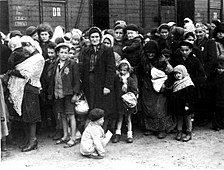
Back ضحايا المحرقة Arabic Víctimas del Holocausto Spanish قربانیان هولوکاست Persian השמדת לא-יהודים במלחמת העולם השנייה HE Vittime dell'Olocausto Italian د ټولوژنې قربانیان Pashto/Pushto Victimele Holocaustului Romanian Holocaust victims SIMPLE Žrtve holokavsta Slovenian Nạn nhân Holocaust Vietnamese
This article's factual accuracy is disputed. (October 2023) |
| Victims | Murdered | Source |
|---|---|---|
| Jews | 6 million | [1] |
| Gentiles (non-Jews) | ||
| Soviet civilians | 4.5 million | [2] |
| Soviet POWs | 3.3 million | [3][1] |
| Poles | 1.8 million | [4][5][1] |
| Serbs | More than 310,000 | [6][7] |
| Disabled people | 270,000 | [8] |
| Romani | 250,000–500,000 | [1][9] |
| Freemasons | 80,000 | [10][11] |
| Slovenes | 20,000–25,000 | [12] |
| Homosexuals | 5,000–15,000 | [13] |
| Spanish Republicans | 3,500 | [14] |
| Jehovah's Witnesses | 1,700 | [1][15] |
| Total | 17 million |
| Part of a series on |
| The Holocaust |
|---|
 |
Holocaust victims were people targeted by the government of Nazi Germany based on their ethnicity, religion, political beliefs, disability or sexual orientation. The institutionalized practice by the Nazis of singling out and persecuting people resulted in the Holocaust, which began with legalized social discrimination against specific groups, involuntary hospitalization, euthanasia, and forced sterilization of persons considered physically or mentally unfit for society. The vast majority of the Nazi regime's victims were Jews, Sinti-Roma peoples, and Slavs but victims also encompassed people identified as social outsiders in the Nazi worldview, such as homosexuals, and political enemies. Nazi persecution escalated during World War II and included: non-judicial incarceration, confiscation of property, forced labor, sexual slavery, death through overwork, human experimentation, undernourishment, and execution through a variety of methods. For specified groups like the Jews, genocide was the Nazis' primary goal.
According to the United States Holocaust Memorial Museum (USHMM), the Holocaust was "the systematic, bureaucratic, state-sponsored persecution and murder of six million Jewish men, women and children by the Nazi regime and its collaborators".[1]
- ^ a b c d e f "Documenting Numbers of Victims of the Holocaust and Nazi Persecution". United States Holocaust Memorial Museum.
- ^ Cite error: The named reference
columbiawas invoked but never defined (see the help page). - ^ Berenbaum 2005, p. 125.
- ^ "Polish Resistance and Conclusions". United States Holocaust Memorial Museum. Archived from the original on 2018-01-02.
Documentation remains fragmentary, but today scholars of independent Poland believe that 1.8 to 1.9 million Polish civilians (non-Jews) were victims of German Occupation policies and the war. This approximate total includes Poles killed in executions or who died in prisons, forced labor, and concentration camps. It also includes an estimated 225,000 civilian victims of the 1944 Warsaw uprising, more than 50,000 civilians who died during the 1939 invasion and siege of Warsaw, and a relatively small but unknown number of civilians killed during the Allies' military campaign of 1944–45 to liberate Poland.
- ^ "Project InPosterum: Poland WWII Casualties". www.projectinposterum.org.
- ^ "Croatia" (PDF). Shoah Resource Center, The International School for Holocaust Studies. Yad Vashem.
- ^ Glišić, Venceslav (12 January 2006). "Žrtve licitiranja - Sahrana jednog mita, Bogoljub Kočović". NIN (in Serbian). Archived from the original on 1 August 2013. Retrieved 8 May 2012.
- ^ "The Danish Center for Holocaust and [Genocide Studies]". Holocaust-education.dk. 1939-09-01. Archived from the original on 2016-03-03. Retrieved 2015-09-27.
- ^ "Genocide of European Roma (Gypsies)". Holocaust Encyclopedia. United States Holocaust Memorial Museum. Retrieved 27 September 2012. The USHMM places the scholarly estimates at 250,000–500,000. According to Berenbaum 2005, p. 126, "serious scholars estimate that between 90,000 and 220,000 were killed under German rule."
- ^ Staff. "Holocaust Memorial Day: FAQs". Grand Lodge of Scotland. Archived from the original on 20 May 2014. Retrieved 31 July 2010.
- ^ Freemasons for Dummies, by Christopher Hodapp, Wiley Publishing Inc., Indianapolis, 2005, page 85, sec. "Hitler and the Nazis"
- ^ The number of Slovenes estimated to have died as a result of the Nazi occupation (not including those killed by Slovene collaboration forces and other Nazi allies) is estimated between 20,000 and 25,000 people. This number only includes civilians: Slovene partisan POWs who died and resistance fighters killed in action are not included (their number is estimated at 27,000). These numbers however include only Slovenes from present-day Slovenia: it does not include Carinthian Slovene victims, nor Slovene victims from areas in present-day Italy and Croatia. These numbers are result of a 10-year-long research by the Institute for Contemporary History (Inštitut za novejšo zgodovino) from Ljubljana, Slovenia. The partial results of the research have been released in 2008 in the volume Žrtve vojne in revolucije v Sloveniji (Ljubljana: Institute for Contemporary History, 2008), and officially presented at the Slovenian National Council ([1]
- ^ Harran, Marilyn J. (2000). The Holocaust Chronicle: A History in Words and Pictures. Publications International Ltd. p. 108. ISBN 9780785329633.
- ^ Cite error: The named reference
:1was invoked but never defined (see the help page). - ^ Shulman, William L. A State of Terror: Germany 1933–1939. Bayside, New York: Holocaust Resource Center and Archives.
© MMXXIII Rich X Search. We shall prevail. All rights reserved. Rich X Search